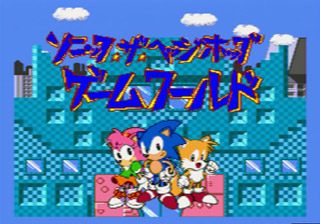:: Sonic the Hedgehog Gameworld ::
Last update: 04/03/06
|
Notice: This page is in need of higher quality screenshots. That probably won't happen until somebody whips up a Pico emulator, which
nobody is lining up to do...
|
:: Quick Jump ::
[Story |
Gameplay Info |
Comparison |
Lost in Translation |
Codes |
Behind the Screens |
Notes |
Miscellanea]
:: Story ::
A Chaos Emerald has been hidden on each floor of Dr. Eggman's 5-story Gameworld, an amusement center built - like everything else he
constructs - in his own mustachioed image. Sonic, Tails, and Amy must clear all the minigames on each floor and find the Emeralds.
:: Gameplay Info ::
The Sega Pico, an electronic toy console designed for young'uns, was introduced in 1994. The unit consists of a cartridge slot, 4
directional keys, one big red action button, and a large touch pad with attached stylus pen. Game cartridges include several "pages" that can be turned like
a book - each "page" represents a screen with different features for the child to interact with in ostensibly educational ways. Among the first slew of
titles released for the Pico was Sonic the Hedgehog Gameworld, a series of minigames with very little educational value to speak of (a fact Sega's American
marketing division struggled to mask).
At the start, young Sonic fans choose to play 1P or 2P, Game Mode or Story Mode, and easy or hard difficulty. Once these decisions have
been made, the wee ones must settle on a character to act as their avatar: Sonic, Tails, or Amy. In Game Mode, players can choose whichever games they want
to play with no overarching goal. In Story Mode, each floor's games are played in succession for points. The goal is to amass more points than Eggman (or
your opponent) by the end of each floor in order to proceed. Most 2P games are played in turns, but three (Car Race, Kinobori Race, and Tama Ire Race) are
simultaneous, with each player in command of a different button.
Each page of the game book represents a different floor of the Gameworld. Kiddies can choose to dive right into a game or chat with the
local anthropomorphic patrons (Sonic, Tails, Amy, Flicky, Pocky, Kucky, Ricky, Picky, Rocky, or Pecky). There are 5 stages altogether (4 floors plus the
roof), and each contains 3-5 attractions for a total of 17 different minigames.
1F
- Car Race (カーレース) -- Beat Eggman in a one-lap kart race around a circular track. Tap the green button
repeatedly to accelerate. First place earns 20 points; second place earns 10. In case of a tie, both players get 20. Eggman's speed increases when
playing on hard mode.
- Kinobori Race (きのぼりレース) -- Tree climbing race. Tap the green button repeatedly to make
your Ai-ai monkey bot scuttle up and down the palmtree as many times as possible within 60 seconds. First place earns 20 points; second place earns
10. In case of a tie, both players get 20. When playing on hard mode, Eggman's Ai-ai climbs faster than on easy.
- Tama Ire Race (たまいれレース) -- Literally, "ball receptacle" race. A ski ball game with
racing icons at the top of the screen. The more points you get with a shot, the more distance your icon will cover. Wait for the power meter to
reach the ideal level, then roll the ball with the green button. First place earns 20 points; second place earns 10. In case of a tie, both
players get 20. On hard mode, your opponents race faster and there's no score display to guide each roll.
- Shoot Game (シュートゲーム) -- Toss 5 basketballs into one of four dashing bipedal hoops. Move
the cursor left and right with the blue and green buttons, respectively, and shoot with the red button. Each basket counts for 4 points, but sink
all 5 and you get an extra 10 point bonus (for a total of 30 points). On hard mode, the baskets run faster and the scoring area for each is smaller.
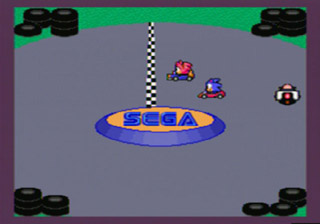
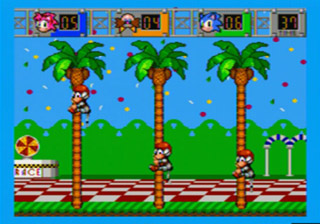
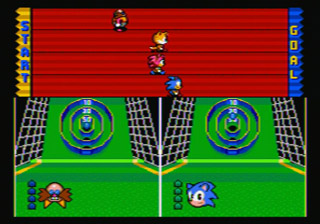
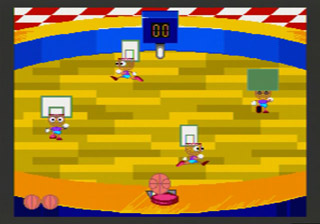
|
2F
- Hataage Game (はたあげゲーム) -- Flag raising game. Eggman raises 1 or 2 flags corresponding to
the blue and green buttons on the keypad. The object is to quickly tap the buttons corresponding to the flag(s) raised. The game ends after 50
seconds or 3 mismatches. A perfect game is worth 20 points, one miss equals 10 points, and 2 misses equal 5 points. On hard mode, the game lasts
for 90 seconds, Eggman whips the flags up at a faster pace, and 3-flag combinations are possible.
- UFO Catcher (ユーフォーキャッチャー) -- Hold down the red action button
until the crane hovers over the toy you have your eye on, then release the button and the claw will lower and attempt to grab whatever is directly
below, be it toy or air. You have 5 chances, with each successful grab being worth 4 points. On hard mode, the claw's gripping radius is less
forgiving.
- Eggman Tataki (エッグマンたたき) -- Eggman assault. Whack-a-mole featuring Eggman's
glorious mug. Use the Touch Pen to maneuver the cursor over the Eggman heads, and use the red action button slam down the mallet. Bop as many
noggins as you can within the time limit. 0-14 bops equals 0 points, 15-20 equals 10 points, and 21+ equals 20 points. On hard mode, the heads pop
up faster and the point requirements are stricter: 0-39 for 0 points, 40-49 for 10 points, and 50+ for 20 points.
- Uranai (うらない) -- Fortune telling. Enter your birthdate along with the birthdate of your desired partner and
the game whips up a compatability rating.
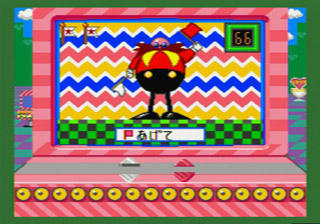
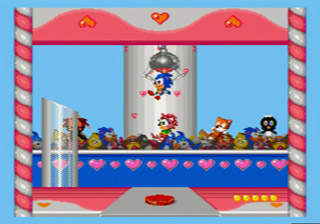
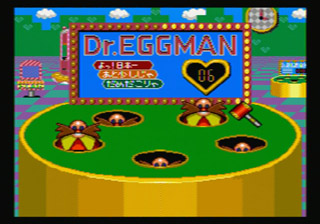
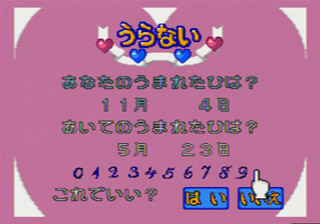
|
3F
- Slot Machine (スロットマシーン) -- Use the Touch Pen to bet Rings. Get three images in a
row for points: cherries equal 3 points, Tails is worth 10, Sonic 20, BAR 50, and three 7's score a whopping 200.
- Roulette Game (ルーレットゲーム) -- Place your bets with the Touch Pen and hope the
spinner lands on your marks.
- Shinkeisuijaku (しんけいすいじゃく) -- Nervous breakdown, the Japanese title for
Concentration. Match up pairs of cards from a group of 12. The game ends if you screw up more than 10 times. You can earn 0, 2, 5, 10, 20, or 30
points based on how many mismatches you made. On hard mode, you're only allowed 5 mismatches.
- Poker Game (ポーカーゲーム) -- Use the Touch Pen to bet Rings. You're dealt a hand of 5 random
cards and the object is to construct matching groups. Use the Touch Pen to select any cards you want to hold and trade the rest for new cards from
the stack. Points are distributed as follows: No Pair = 0, One Pair = 1, 2 Pair = 2, 3 Card = 3, Full House = 4, 4 Card = 8, and 5 Card = 16.
- Bakudan Nuki (バクダンぬき) -- The title is a pun of Babanuki, or Old Maid, with the maid
(baba) being replaced with a bomb (bakudan). Both players begin with 5 or 6 cards, and out of the 13 all are pairs except for a single bomb card.
Keep pulling random cards out of Eggman's deck to pair up with cards in your own hand. Once all the pairs have been removed from the deck, the
person left holding the bomb card is the loser.
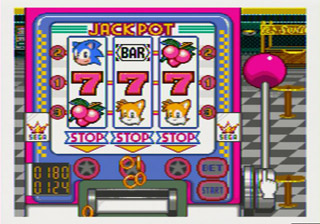
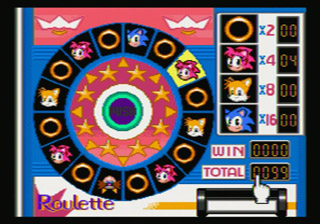
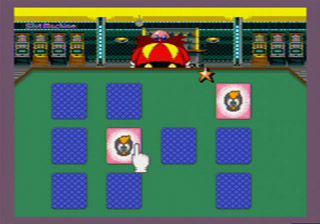
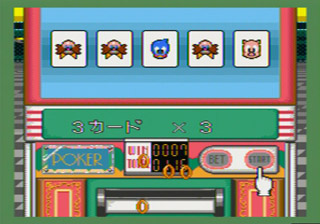
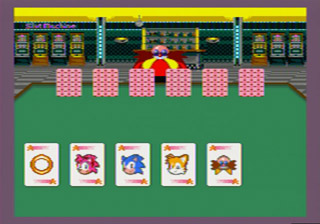
|
4F
- Janken Game (ジャンケンゲーム) -- Rock-paper-scissors game. Challenge Eggman in the
ultimate game of honor and prestige. Use the Touch Pen to choose your maneuver in preparation for Eggman's randomly-selected onslaught. The game
ends after 5 rounds, with point distribution as follows: lose 3 or more rounds for 0 points, 2 rounds for 3 points, 1 round for 10 points, or win a
perfect 5 rounds for 20 points.
- Tamago no Nakami wa? (たまごのなかみは?) -- What's inside the egg? 4 eggs, one of
which contains Flicky, are laid out on a table. Keep your eye on the Flicky egg as Eggman mixes them up. Once the Doc has done his dirty work, try
to pick out the egg containing the bluebird of Sega lore. The game lasts 4 rounds or 2 screw-ups, with each successful guess worth 5 points. On
hard mode, Eggman whips the eggs around faster and if you make even one bad guess, the game ends.
- Kakutou Roulette (かくとうルーレット) -- Hand-to-hand fight roulette. Sonic and
Eggman engage in bloody mortal combat. You control the action with a roulette that picks a random attack maneuver. Use the Touch Pen to start and
stop the roulette at will. The ensuing action depends on where the cursor stops: fist (Sonic punches), foot (Sonic kicks), spin (Sonic spins),
Eggman head (Eggman attacks), or question mark (random). Sonic starts with 10 hit points while Eggman begins with 5. The winner earns 20 points.
On hard mode, both Sonic and Eggman begin with 5 hit points.
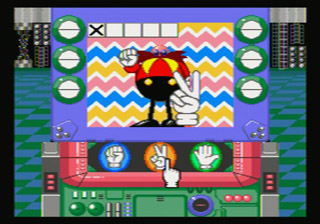
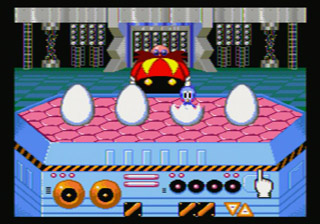
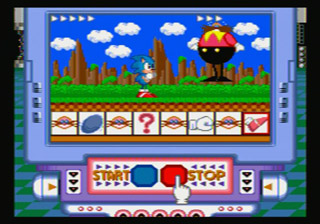
|
roof
- Chaos Sagashi Game (カオスさがしゲーム) -- Chaos search game. Once on the rooftop,
retreat through all 4 levels of the Gameworld in a race against Eggman to find the Chaos Emeralds hidden on each floor. Move your character with the
four directional buttons and investigate all the game machines. If you encounter a trap, you'll be momentarily stunned. Once all 5 Emeralds have
been located, the character holding the most wins the game.
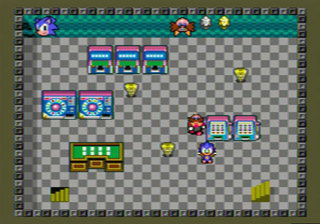
|
:: Lost in Translation ::
Due to the nature of the software and the target audience, Sonic's Gameworld suffered a number of critical blows in the localization
process. The scope of what's considered acceptable material for young children is much narrower in the West than in Japan, and all minigames that couldn't
be linked (however feebly) to some manner of educational process were removed from the American version of the game. All the casino-themed games are spliced
out, fortune telling and rock-paper-scissors are history, the entire third floor is gone, and the remaining games are shuffled around. All told, only 11 of
the original 17 games survived the mass slaughter. There is no Story Mode, only the basic Game Mode, and the character voices are dubbed in English. Here's
a rundown of the US version of the game:
1F
Car Race -- No changes.
Sonic-Ball -- Tama Ire Race.
Hoops -- Shoot Game.
Tree Climb -- Kinobori Race.
2F
Flag Game -- Hataage Game. Flag colors are changed to purple and green to correspond with the slightly different color scheme of the US
Pico unit.
Toy Drop -- UFO Catcher.
Robotnik Bop -- Eggman Tataki. The "Dr. Eggman" on the billboard is changed to "Dr. Robotnik".
3F
Egg Switch Game -- Tamago no Nakami wa?
Concentration Memory Cards -- Shinkeisuijaku. The sole surviving member of the casino floor. The background (which originally featured
slot machines) has been removed.
Sonic vs. Robotnik -- Kakutou Roulette. This version has been altered so that there's no actual punching, kicking, spin dashing, or any
other violent behaviors that might give America's impressionable youth the wrong idea. Now Sonic and Robotnik simply toss Rings at each other. The
roulette consists of Sonic heads (Sonic tosses), Robotnik heads (Robotnik tosses), Rings (Sonic gets 1 unit restored to his health bar), and question
mark (random).
4F
Diamond Maze -- Chaos Sagashi Game.
5F
Exclusive to the US version is a simple drawing tool that allows kids to channel their frustrations over censored content into artistic energy.
Use the touch pen and pad to doodle freehand with a variety of pencil shapes and colors. Pre-programmed effects and stamps can be added to the
picture.
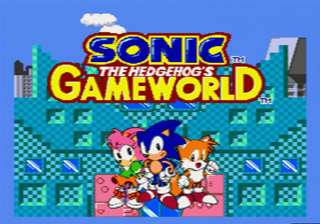
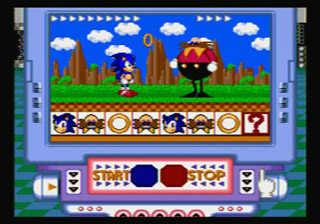
Written content and original graphics copyright © 1997-2007 Jared Matte. Screenshots and game information thanks to
Act Select. Hosting and administration thanks to Nathan Tsui. Sonic the Hedgehog
characters, logos, and images are trademarks of SEGA Corporation. The GHZ is an independent fansite and is not affiliated
with SEGA Corporation.
|



